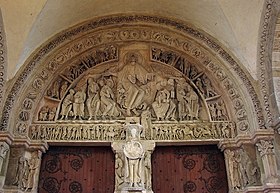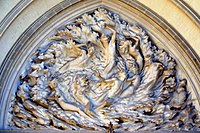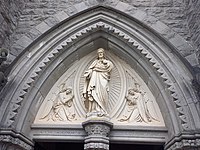
A tympanum ( pl.: tympana; from Greek and Latin words meaning "drum") is the semi-circular or triangular decorative wall surface over an entrance, door or window, which is bounded by a lintel and an arch. [1] It often contains pedimental sculpture or other imagery or ornaments. [2] Many architectural styles include this element. [3]
Alternatively, the tympanum may hold an inscription, or in modern times, a clock face.
History
In ancient Greek, Roman and Christian architecture, tympana of religious buildings often contain pedimental sculpture or mosaics with religious imagery. [4] A tympanum over a doorway is very often the most important, or only, location for monumental sculpture on the outside of a building. In classical architecture, and in classicising styles from the Renaissance onwards, major examples are usually triangular; in Romanesque architecture, tympana more often have a semi-circular shape, or that of a thinner slice from the top of a circle, and in Gothic architecture they have a more vertical shape, coming to a point at the top. These shapes naturally influence the typical compositions of any sculpture within the tympanum.
The upper portion of a gable when enclosed with a horizontal belt course, is also termed a tympanum. [5]
Bands of molding surrounding the tympanum are referred to as the archivolt. [6]
In medieval French architecture, the tympanum is often supported by a decorated pillar called a trumeau.
Gallery
-
Baroque tympanum in the Queen's Bedroom in the Louvre Palace, Paris, by Michel Anguier and Pietro Sasso, with a painting of Judith and Holophernes, by Giovanni Francesco Romanelli, 1655 [7]
-
Ex Nihilo (Out of Nothing) by Frederick Hart, tympanum over center doors, Washington National Cathedral, US
-
Tympanum of Kumari-ghar at Basantapur Durbar Square, Kathmandu
-
The three tympana on the main façade of Notre-Dame de Paris, France
-
Sculpted tympanum in Stralsund, Germany
-
Adoration of the Magi on a tympanum on Saint-Thiébaut Church, Thann, France
-
Religious scene in a tympanum, Church San Lorenzo, Vicenza, Italy
-
Scenes of the lives of Saint Peter and Mary, St Peter's, Vitoria-Gasteiz, Spain
-
High-relief bronze tympanum of Writing, Thomas Jefferson Building, Washington, D.C., US
-
Tympanum (showing the tree of life) and archivolt at Church of St Mary and St David, Kilpeck, Herefordshire, England
-
Tympanum showing Christ in Majesty with four attendant angels, Rowlestone, Herefordshire, England
-
Tympanum of the Manila Cathedral in Intramuros, Philippines
-
Tympanum of the church of the Sacred Heart, Templemore, Ireland
See also
- Lunette: semi-circular tympanum
- Church architecture
- Gable
- Pediment
- Portal
Citations
- ^ "Glossary - Tympanum". Architecture of the Indian Subcontinent. Archived from the original on 2012-03-06. Retrieved 2007-06-28.
- ^ "Glossary of Medieval Art and Architecture - tympanum". University of Pittsburgh. Archived from the original on 2018-01-16. Retrieved 2007-06-23.
- ^ "Illustrated Architecture Dictionary - Tympanum". www.buffaloah.com. Archived from the original on 2014-06-22. Retrieved 2014-04-12.
- ^ "Tympanum". www.OntarioArchitecture.com. Archived from the original on 2018-02-26. Retrieved 2007-06-25.
- ^ One or more of the preceding sentences incorporates text from a publication now in the public domain: Chisholm, Hugh, ed. (1911). " Tympanon". Encyclopædia Britannica. Vol. 27 (11th ed.). Cambridge University Press. p. 498.
- ^ "Glossary of Medieval Art and Architecture - archivolt". University of Pittsburgh. Archived from the original on 2018-01-13. Retrieved 2007-06-23.
- ^ Bresc-Bautier, Geneviève (2008). The Louvre, a Tale of a Palace. Musée du Louvre Éditions. p. 56. ISBN 978-2-7572-0177-0.
![Baroque tympanum in the Queen's Bedroom in the Louvre Palace, Paris, by Michel Anguier and Pietro Sasso, with a painting of Judith and Holophernes, by Giovanni Francesco Romanelli, 1655[7]](https://upload.wikimedia.org/wikipedia/commons/thumb/2/26/Ceilings_of_the_appartements_d%27%C3%A9t%C3%A9_de_la_reine_Anne_d%27Autriche_%28449%29_%28tympanum_cropped%29.jpg/200px-Ceilings_of_the_appartements_d%27%C3%A9t%C3%A9_de_la_reine_Anne_d%27Autriche_%28449%29_%28tympanum_cropped%29.jpg)












